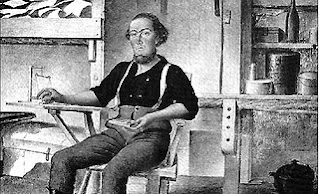Places: Fort Laramie, Wyoming
Forts served many purposes in the American west. Just because a place was called a fort didn't necessarily make it a military installation. Fur traders, either working for a company or independents such as William Sublette or Jim Bridger, also fortified their trading posts. Because these trading forts were situated in good locations for local tribes to gather, they were often taken over later as military posts and became the site of treaty parleys. Such is the story of Fort Laramie in Wyoming.
Fort Laramie, now a National Historic Site, is located on the junction of the North Platte and Laramie Rivers in the Upper Platte Valley. William Sublette, a Kentucky-born trader and scout, chose the location for a trading post in 1834 and named it for himself, Fort William. In 1841, John Jacob Astor's American Fur Company bought the property from Sublette and named the place Fort John, but not after Astor. Finally, in 1849, as more and more emigrants came over the Oregon Trail, heading to Oregon and then into California, the United States military took over the fort. At the time, it was known as Fort John at the Laramie River, later shortened to Fort Laramie.
So, who or what was Laramie. In 1816, a Canadian fur trapper named Jacques La Ramie passed through the area in 1819 and was never seen again. Rumor, unproven, held that he'd been killed by an Arapahoe war party. Supposedly, his body was thrown into the river which now bears his name, as does the Laramie Mountains, and now Laramie, and Fort Laramie, Wyoming. By the time William Sublette claimed the site and began to set up his trading post, emigrants were already heading toward Oregon. John Sarpy, a partner in the American Fur Company, acquired the site from Sublette. Fort John commemorates his tenure at the post. The U.S. Army began using the fort by 1846, and later took it over entirely. It soon became a focal point for treaty parleys with local tribes, beginning with the 1851 Treaty of Fort Laramie.
Because of the treaty, Fort Laramie wasn't directly involved in warfare with local tribes though it often served as a staging area during conflicts with the Natives. The post was understaffed by volunteers and ex-Confederates turned Yankees during the Civil War. However, in 1866 Lt. John Phillips galloped 236 from Fort Phil Kearney to For Laramie to get help after the Fetterman Massacre. How many horses he wore out during his epic ride will never be known, but the one he was on collapsed as he entered the fort gates. During the Bozeman war, 1866-1868, the fort was a staging area for troops and a second Treaty of Fort Laramie in 1868, with the Sioux. Fort Laramie was again a staging area during the Great Sioux War, 1876-1877. With the building of the Transcontinental Railroad, Fort Laramie became a backwater and was decommissioned in 1890. Local farmers salvaged materials from the buildings and the land around the fort was opened to homesteaders. In 1983, the Forest Service took control of 536 acre historic district compromising the fort and its original outbuildings, now in ruins.
Fort Laramie, now a National Historic Site, is located on the junction of the North Platte and Laramie Rivers in the Upper Platte Valley. William Sublette, a Kentucky-born trader and scout, chose the location for a trading post in 1834 and named it for himself, Fort William. In 1841, John Jacob Astor's American Fur Company bought the property from Sublette and named the place Fort John, but not after Astor. Finally, in 1849, as more and more emigrants came over the Oregon Trail, heading to Oregon and then into California, the United States military took over the fort. At the time, it was known as Fort John at the Laramie River, later shortened to Fort Laramie.
So, who or what was Laramie. In 1816, a Canadian fur trapper named Jacques La Ramie passed through the area in 1819 and was never seen again. Rumor, unproven, held that he'd been killed by an Arapahoe war party. Supposedly, his body was thrown into the river which now bears his name, as does the Laramie Mountains, and now Laramie, and Fort Laramie, Wyoming. By the time William Sublette claimed the site and began to set up his trading post, emigrants were already heading toward Oregon. John Sarpy, a partner in the American Fur Company, acquired the site from Sublette. Fort John commemorates his tenure at the post. The U.S. Army began using the fort by 1846, and later took it over entirely. It soon became a focal point for treaty parleys with local tribes, beginning with the 1851 Treaty of Fort Laramie.
Because of the treaty, Fort Laramie wasn't directly involved in warfare with local tribes though it often served as a staging area during conflicts with the Natives. The post was understaffed by volunteers and ex-Confederates turned Yankees during the Civil War. However, in 1866 Lt. John Phillips galloped 236 from Fort Phil Kearney to For Laramie to get help after the Fetterman Massacre. How many horses he wore out during his epic ride will never be known, but the one he was on collapsed as he entered the fort gates. During the Bozeman war, 1866-1868, the fort was a staging area for troops and a second Treaty of Fort Laramie in 1868, with the Sioux. Fort Laramie was again a staging area during the Great Sioux War, 1876-1877. With the building of the Transcontinental Railroad, Fort Laramie became a backwater and was decommissioned in 1890. Local farmers salvaged materials from the buildings and the land around the fort was opened to homesteaders. In 1983, the Forest Service took control of 536 acre historic district compromising the fort and its original outbuildings, now in ruins.




Comments
Post a Comment